Join More Than 50,000+ Subscribers and get latest camera news and rumors
NEW CAMERA VIDEOS ON YOUTUBE
|
By admin, on May 31st, 2025
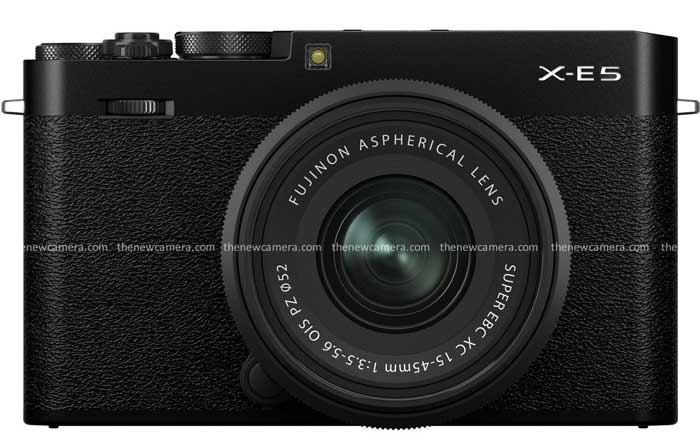
We have first shared the Fuji X-E5 expected core Specification in our May 2021 Post too, you can check here. Now, its almost confirmed that the comaera is coming with the same core specs. With no updates from the rumor mill’s reliable sources, it’s confirmed that the upcoming Fuji X-E5 camera will feature 40 MP X-Trans CMOS sensor and IBIS unit. Take a look at the detailed core specification of the upcoming camera
Fuji X-E5 specification
- 40MP APS-C X-Trans CMOS 5 HR Sensor
- 4K Video Recording at 60p, 6.2K at 30p (4:2:2 10-Bit)
- In-Body Image Stabilization (IBIS)
- 425-Point Intelligent Hybrid Autofocus System
- 3.69 m-Dot OLED Electronic Viewfinder
- 3″ 1.84 m-Dot Tilting Touchscreen LCD
- 20 fps Electronic Shutter, 15 fps Mechanical Shutter
- 160MP Pixel Shift Multi-Shot
- Bluetooth and Wi-Fi Connectivity
- ProRes & Blackmagic RAW via HDMI
Fuji X-E5 Arrival Time and Price
Fuji X-E5 is coming on June 12, 2025. The price is expected to be $1299, approximately
Follow us for more updates and Get LIVE RUMORS –> FACEBOOK | TWITTER | INSTAGRAM to get live news — > get live news + –> See More Fuji Rumors
source FR.com
By admin, on May 30th, 2025
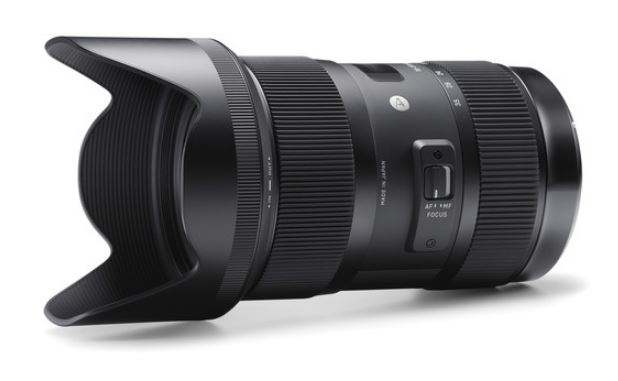 Image of Sigma 18-35mm F1.8 APS-C Lens According to the latest rumour coming from the rumour mill on June 17, 2025, Sigma is going to announce two new lenses for Canon APS-C mount cameras, that is the RF-S mount, and the two lenses are:
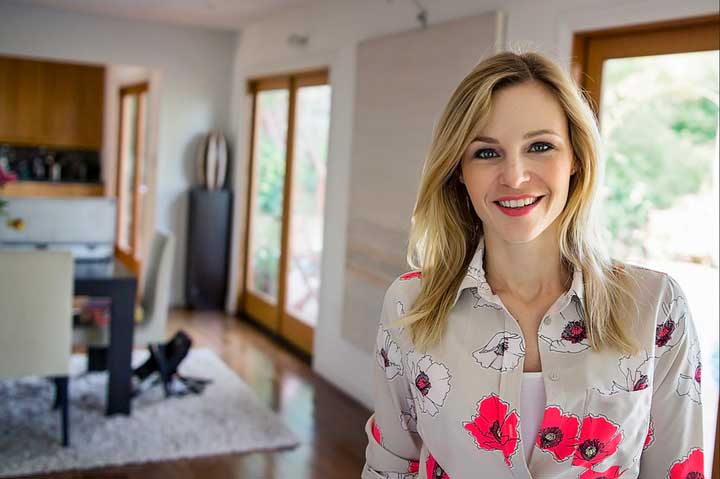 Sample image of Sigma 18-35mm F1.8mm Lens Sigma 17-40mm F1.8 DC DN ART
Do you remember the 18-35mm F1.8 lens that was available in the DSLR time? Of course, I missed that lens very badly, and I wondered why Sigma isn’t announcing any alternative to that lens, which was popular among professional APS-C users then. Now, finally, we have a solution. We have a brand new RF-S lens with the same F1.8 constant aperture and a slightly broader focal length.
The lens has a 27-64mm (35mm equivalent) focal length, and without a doubt, it will deliver exceptional image quality to the users. Just imagine pairing the Sigma 17-40mm F1.8 lens with the recently announced Canon R50 V camera—for wedding cinematography or for professional content creation, it will deliver, as I have said, exceptional results to the user.
The expected price of the Sigma lens is somewhere around $1200—that is what I am expecting. I will update this post once the price information is available to us.
Now, the next lens, which is also coming for the RF-S mount:
Sigma 12mm F1.4 DC DN Contemporary lens
So this particular lens will become very popular among handheld content creators—those who love to have an ultra-wide lens with a bright maximum aperture to deliver the finest quality possible.
Stay tuned for more updates coming
The article “6:34 pm, Friday, 30 May 2025, Greenwich Mean Time (GMT)” was published at 4:24 pm, Tuesday, 27 May 2025, Greenwich Mean Time (GMT). By thenewcamera.com Team. You can Follow us on our social pages FACEBOOK | TWITTER | INSTAGRAM to get live Camera News + Canon Rumors 24X7.
Source – SAR website
By admin, on May 30th, 2025
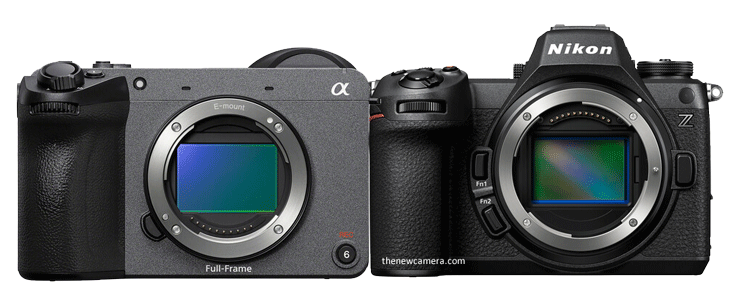
Sony FX2 versus the Nikon Z6 Mark III camera, let’s explore the differences between the two point by point
The Nikon Z6 Mark III camera is slightly larger, with a photography-friendly body and controls. The Sony FX2 does have a deep hand grip, but it has a somewhat boxy design. The thing that makes a big difference between the two, specifically in the design part, is that Sony is made for cinematography purposes and carries a lot of tripod threads all over the body to mount it perfectly in cinema rigs. The other advantage we have with the Sony FX2 camera is the moving viewfinder.
Nikon Z6 III and the Sony FX2 — both of them support dual card slots, one dedicated for CFexpress and one SD card slot. The Nikon Z6 Mark III monitor is slightly larger and of higher resolution, so users may experience better LCD quality with the Z6 Mark III camera. At the very same time, the electronic viewfinder is also a 5.76 million-dot unit compared to a 3.6 million-dot electronic viewfinder in Sony, but yeah, we are getting better display units in the Nikon Z6 Mark III.
The wireless functionality of the two is almost the same, but Nikon does have GPS support via smartphone to enable geotagging functionality for travel purposes, documentary work, or maybe for photojournalism purposes. The FX Mark 2 camera misses out. Although the humidity tolerance and the weatherproof criteria of both cameras match each other, so we literally do have almost the same build quality in both cameras.
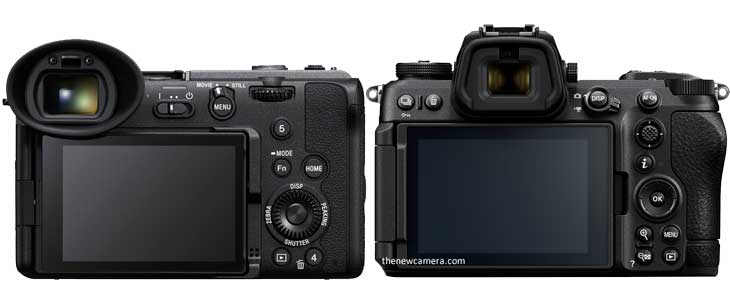
Design Comparison
| Feature |
Sony FX2 |
Nikon Z6 III |
| Lens Mount |
Sony E |
Nikon Z |
| Material of Construction |
Magnesium Alloy |
Magnesium Alloy |
| Dimensions (W x H x D) |
5.1 x 4.1 x 3.1″ / 129.7 x 103.7 x 77.8 mm |
5.5 x 4 x 2.9″ / 138.5 x 101.5 x 74 mm |
| Weight |
1.3 lb / 594 g (Body Only), 1.5 lb / 679 g (With Battery, Recording Media) |
23.6 oz / 670 g (Body Only) |
| Shoe Mount |
1x Intelligent Hot Shoe |
1x Hot Shoe |
| Tripod Mounting Thread |
2x 1/4″-20 Female (Bottom) |
1x 1/4″-20 Female (Bottom) |
| Accessory Mounting Thread |
3x 1/4″-20 on Camera Body |
Not specified |
| Operating Conditions |
32 to 104°F / 0 to 40°C |
32 to 104°F / 0 to 40°C up to 85% Humidity |
| Media/Memory Card Slot |
Slot 1: CFexpress Type A / SD (UHS-II)
Slot 2: SD/SDHC/SDXC (UHS-II) |
Slot 1: CFexpress Type B / XQD
Slot 2: SD/SDHC/SDXC (UHS-II) |
| Wireless |
2.4 GHz Bluetooth 5.0, 2.4 / 5 GHz Wi-Fi (802.11a/b/g/n/ac) |
2.4 / 5 GHz Wi-Fi 5 (802.11ac), Bluetooth 5.0 |
| Mobile App Compatible |
Yes: Android & iOS (Sony |
Creators’ App |
| Global Positioning |
No |
GPS (via Connected Smartphone) |
| Monitor |
3″ Tilting Touchscreen LCD, 1,036,800 Dot |
3.2″ Articulating Touchscreen LCD, 2,100,000 Dot |
| Viewfinder |
Electronic (OLED), 3,686,400 Dot / Titling EVF |
Electronic, 5,760,000 Dot, 0.5″ |
Best Camera for Photographers
Sony FX2 camera offers higher resolution at 33 megapixels, but at the very same time, the Nikon Z6 Mark 3 camera offers 24.5 megapixel resolution, which is of course limited. But if you talk about sensor architecture, then the Nikon Z6 Mark 3 camera is using a partially stacked CMOS sensor.
Video Recording: Nikon Z6 III Excels
Of course, the Sony FX2 camera is able to create highly detailed 4K 30fps footage from a 7K oversampled file. At the very same time, when you are recording videos at 4K 60 frames per second or 4K 120 frames per second with the Nikon Z6 Mark 3 camera—and of course, to be noted—4K 120 FPS is not possible with the Sony FX2 despite being in a higher price range. Other than that, even when you are trying to record 4K @ 60 frames per second, at that time you have to face a 1.5x crop in the Sony FX2. So with the FX2, we have limitations attached in the higher frame rate, and 4K 120 is not possible.
Continuous Shooting Speed Comparison
The same advantage we also get in the continuous shooting speed of the camera, where we are able to get up to 20 FPS RAW, and up to 60 frames per second in full resolution, and up to 120 frames per second in the DX crop mode. Thankfully, the Sony FX2 camera is using a mechanical shutter, but despite that, the continuous shooting speed of the camera remains limited to 11 frames per second.
Autofocus: Sony FX2’s Precision
When you dive into autofocus performance, each system really brings something different to the table. Sony’s FX2 boasts a whopping 759 phase-detection points (compared with Nikon’s 299 “hybrid” points), which means it can lock onto—and keep track of—moving subjects across with Sony’s famous AI AF. That’s a huge advantage when you’re shooting fast-paced street scenes or busy event coverage.
Nikon Z6 III’s Low-Light Autofocus
On the other hand, Nikon’s autofocus shines in low-light situations. With a sensitivity down to –10 EV (versus Sony’s 4 EV), the Z6 III can find and focus on subjects in near-darkness—perfect for late-night cityscapes, dimly lit weddings, or cozy indoor gatherings.
Autofocus Tracking: Nikon Closing the Gap
Recent reviews peg the Z6 III’s subject recognition and tracking as nearly on par with Sony’s vaunted system, so you’re not really “giving up” much by choosing Nikon—especially if you need that extra push in challenging light. Still, many pros continue to call Sony the gold standard for sheer reliability, so it really comes down to what kind of shooting you do most often.
Image Stabilization: Nikon’s Edge
Sensor-shift image stabilization of the Nikon Z6 Mark 3 is more helpful, since you can link your autofocus point with the VR system of the camera, and you will be getting a true 7.5 stops of stabilization all the time, even if you are focusing in the corner of the frame. Sony’s Active Image Stabilization is highly effective in video mode, but when you are talking about stills, it’s the traditional-style IBIS system we are getting.
Why Choose Nikon Z6 III for Pros
Nikon Z6 Mark III camera, due to its partially stacked CMOS sensor and Expeed 7 image processor, the autofocus calculation is being done at the rate of 120 frames per second in-camera. So the autofocus and the auto exposure refresh rate is actually 120 FPS. And due to the introduction of a new artificially intelligent autofocus algorithm inside the camera, the overall photographic experience is now elevated to the next level.
So if you are a professional photographer, then the Nikon Z6 Mark 3 will be a perfect choice for your requirements.
Photographic Features Compared
| Feature |
Sony FX2 |
Nikon Z6 III |
| Sensor Resolution |
Actual: 34.1 MP, Effective: 33 MP |
Actual: 26.79 MP, Effective: 24.5 MP (6048 x 4032) |
| Image Sensor |
35.9 x 23.9 mm (Full-Frame) CMOS |
35.9 x 23.9 mm (Full-Frame) Partially Stacked CMOS |
| Image Stabilization |
Sensor-Shift, 5-Axis, Active IS |
Sensor-Shift, 5-Axis, AF points can be linked to VR |
| ISO Sensitivity |
Native 100-51,200 (50-204,800 Extended) |
Photo: Native 100-64,000 (50-204,800 Extended) |
| Shutter Type |
Mechanical Focal Plane and Electronic Rolling Shutter |
Mechanical Focal Plane and Electronic Rolling Shutter |
| Shutter Speed |
1/8000 to 30 Seconds (Photo) |
1/8000 to 15 Minutes (Mechanical), 1/16000 to 15 Minutes (Electronic) |
| Continuous Shooting |
Not specified in the provided data (10 fps per web sources) |
Up to 20 fps at Maximum Resolution |
| Autofocus Points |
Photo: Phase Detection: 759 |
Photo, Video: Contrast Detection, Phase Detection: 299 |
| Autofocus Sensitivity |
4 to +20 EV |
-10 to +18 EV |
| White Balance |
2500 to 9900K |
2500 to 10,000K, Presets: Auto, Cloudy, Color Temperature, Direct Sunlight, Flash, Fluorescent, Incandescent, Shade |
| Image File Format |
Not specified (JPEG, Raw per web sources) |
HEIF, JPEG, Raw |
| Bit Depth |
Not specified (14-bit per web sources) |
14-Bit |
Best Camera for Video
When it comes to video, the Z6 III feels like a powerhouse that’s ready to stretch your creativity. Imagine being able to capture in gorgeous ProRes RAW—right inside the camera—at up to 6K/60p. With the help of the stacked CMOS sensor, the camera can record 6K 60fps videos. Despite being a consumer hybrid mirrorless camera, the Nikon Z6 Mark III is able to deliver 6K resolution, that is really a big surprise.
That means you’ve got room to push and pull your colors, tweak contrast, and hold onto every bit of shadow and highlight detail without worrying about external recorders or cables.
Nikon Z6 Mark III Slow-Motion Capabilities
And if you need silky-smooth slow-mo or a little extra resolution, you can jump into uncropped 4K/120p or even 1080p/240p modes. While shooting 4K 120 frames per second, you have to face a 1.5x DX crop, and when you are shooting 4K @ 60 frames per second, there is a negligible amount of crop, which remains unnoticeable.
Sony FX2 Video Features
Sony’s FX2 isn’t slouching, though. It delivers clean, 10-bit H.264/H.265 internally and will give you oversampled 4K/30p for sharp, detailed footage. If you really need that ProRes RAW goodness, you can use an external recorder via HDMI—but that means more gear hanging off your rig. And when you want to push the frame rate higher in 4K—meaning if you want to record your 4K videos at 60 frames per second—you have to face a 1.5x crop, and there is no 120 frames per second option available in the Sony FX2 while recording 4K videos.
Sony FX2 Live-Streaming Advantages
Where Sony shines is in its live-streaming chops: built-in RTMP/RTMPS and SRT support make it a dream camera for one-person streaming setups, whereas the Z6 III leaves you hunting for a separate encoder. Both cameras give you flexible picture profiles—N-Log on Nikon holds up beautifully alongside Sony’s S-Log 3 and S-Cinetone—but in professional circles, S-Log and Cinetone have built a bit more of a buzz.
Audio and Rolling Shutter Comparison
Don’t forget audio: both record in 24-bit LPCM, but Sony’s extra channels give you more mics or ambient tracks to play with. And if rolling shutter is a worry, Nikon’s stacked sensor really pulls ahead—its readout is faster, so you’ll see far less “jello” when you whip the camera side-to-side at 4K/60p or 120p.
Nikon Z6 III vs. Sony FX2: Which to Choose?
In short, if you’re a solo shooter who loves to color-grade, chase cinematic slow-mo, and keep your rig light, the Z6 III’s internal RAW and high-speed modes deliver. If you’re streaming live, mixing multiple audio sources, or don’t mind an external recorder for 16-bit RAW, the FX2’s built-in streaming and flexible codecs have you covered.
Video Comparison
| Feature |
Sony FX2 |
Nikon Z6 III |
| RAW |
16 BIT via HDMI |
12 Bit internally |
| MAX RES. |
4K 60p |
6K 60p N-RAW, 6K 30p ProRes RAW |
| Internal Recording Modes |
H.264/H.265 8/10-Bit:
UHD 4K (3840 x 2160) at 23.98/25/29.97/50/59.94 fps
DCI 4K (4096 x 2160) at 23.98/24/25/29.97/50/59.94 fps
|
ProRes RAW/ProRes RAW HQ/Raw: 6048 x 3404 at 23.98/25/29.97/50/59.94 fps
4032 x 2268 at 23.98/25/29.97/50/59.94 fps 3984 x 2240 at 23.98/25/29.97/50/59.94/100/120 fps
UHD 4K (3840 x 2160) at 23.98/25/29.97/50/59.94/100/120 fps
|
| Format and codes |
16 Bit RAW, 10-Bit 4:2:2 XAVC S-I |
12 Bit RAW, |
| 4k 60 FPS |
Yes, 1.5X Crop |
Yes, No crop at 4k 60FPS |
| 4K 120 FPS |
No |
Yes, 1.5X Crop |
| External Recording Modes |
4:2:2 8/10-Bit via HDMI:
DCI 4K (4096 x 2160)
UHD 4K (3840 x 2160)
HD (1920 x 1080)
Raw 16-Bit: 4672 x 2628 |
HDMI: UHD 4K (3840 x 2160) |
Dual Native ISO
|
Dual Base 800/4000 |
Dual Native ISO 800 |
| Built-in Fan |
Yes |
No |
| Video IS |
Very effective / Active IS + Gyro |
Mechanical IBIS + EVR |
| Fast-/Slow-Motion Support |
Yes |
Slow-Motion Only |
| Gamma Curve |
HDR-HLG, Rec709, S Cinetone, Sony S-Log 3, Standard |
HDR-HLG, Nikon N-Log |
| Anomorphic Lenses support |
Yes |
No |
| Audio Recording |
2/4-Channel 24-Bit 48 kHz LPCM
2-Channel 16-Bit 48 kHz LPCM |
16-Bit 48 kHz AAC Audio
2-Channel 24-Bit 48 kHz LPCM Audio |
| IP Streaming |
RTMP, RTMPS, SRT: 1280 x 720 to 3840 x 2160 at 25p, 29.97p, 50p, 59.94p |
No |
Buy Nikon Z6 Mark III from Amazon.com | B&H Camera store
Buy Sony FX2 From B&H Store
also see
Which one is the Best Camera for Recording Video – Panasonic Lumix S1 II vs. Nikon Z6 III?
Best Lenses for Nikon Z6 III
By admin, on May 29th, 2025

The Sony FX2 is an extended version of the Sony A7 IV, optimised for its maximum cinematography specifications. So hardware-wise, both the cameras are the same — is it true? NO, we do have some sort of advancement in the hardware part, and the advancement is the introduction of the AI chip, which was absent in the Sony A7 IV, as well as the very unique tiltable electronic viewfinder design. So let’s explore the differences between the two.
Design Comparison
| Feature |
Sony A7 IV |
Sony FX3 |
| Lens Mount |
Sony E |
Sony E |
| Material |
Magnesium Alloy |
Magnesium Alloy |
| Dimensions (W x H x D) |
5.2 x 3.8 x 3.1″ (131.3 x 96.4 x 79.8 mm) |
5.1 x 4.1 x 3.1″ (129.7 x 103.7 x 77.8 mm) |
| Weight |
1.4 lb (658 g, with battery and media) |
1.5 lb (679 g, with battery and media); 1.3 lb (594 g, body only) |
| Media Slots |
Slot 1: CFexpress Type A / SD (UHS-II); Slot 2: SD/SDHC/SDXC (UHS-II) |
Slot 1: CFexpress Type A / SD (UHS-II); Slot 2: SD/SDHC/SDXC (UHS-II) |
| Video I/O |
1x HDMI Output |
1x HDMI Output, 1x USB-C 3.0/3.1/3.2 Gen 1 Output / Lightspeed 10 Gbps |
| Audio I/O |
1x 3.5 mm TRS Stereo Mic Input, 1x 3.5 mm TRS Stereo Headphone Output |
1x 3.5 mm TRS Stereo Mic Input, 1x 3.5 mm TRS Stereo Headphone Output / XLR input |
| Other I/O |
1x Sony Multi/Micro-USB, 1x USB-C (USB 3.2 Gen 1) |
1x Micro-USB, 1x USB-C |
| Wireless |
Wi-Fi 4 (802.11n), Bluetooth 4.1 |
2.4/5 GHz Wi-Fi (802.11a/b/g/n/ac), Bluetooth 5.0 |
| Mobile App |
Creators’ App (Android/iOS) |
Sony Creators’ App (Android/iOS) |
| GPS |
Yes, via a connected smartphone |
No |
| Display |
3.0″ Free-Angle Tilting Touchscreen LCD, 1,036,800 Dot |
3.0″ 180° Tilting Touchscreen LCD, 1,036,800 Dot |
| Viewfinder |
Electronic (OLED), 0.5″, 3,680,000 dots, 0.78x magnification / Tiltable EVF |
Electronic (OLED), 3,686,400 Dot (no size/magnification specified) |
| Shoe Mount |
1x Intelligent Hot Shoe |
1x Intelligent Hot Shoe |
| Tripod Mount |
1x 1/4″-20 Female (Bottom) |
2x 1/4″-20 Female (Bottom), 3x 1/4″-20 on Camera Body |
| Battery |
NP-FZ100, ~520 shots |
NP-FZ100, power consumption ≤6.6 W |
| Operating Conditions |
32 to 104°F (0 to 40°C) |
32 to 104°F (0 to 40°C) |

What advantages do we have in the new Sony FX2 camera over the Sony A7 IV?
- It looks like a cinema camera, but it has a very deep hand grip and a very innovative tiltable electronic viewfinder.
- Additionally, we have an option in FX2 to use an XLR handle for the body part, and with that grip, we can add 32-bit audio to our videos.
- An option to record DCI 4K instead of UHD 4K in the new Sony FX2 camera with lots of custom LUTs as well as an option of extended dual native ISO range, resulting in 15 stops of DR performance.
- 30% increase in the AI autofocus performance of the new Sony FX2 camera compared to the Sony A7C Mark II or the A7 Mark IV camera.
- 16-bit RAW video recording is an option available via the HDMI port. Obviously, the Sony A7 Mark IV camera remains limited to 10-bit video.
- Introduction of active stabilisation mode as well as frame stabiliser — both of these are not in the way they should be in the Sony A7 Mark IV due to the absence of the dedicated AI chip inside the body.
- Support for anamorphic lenses and in-camera de-squeeze functionality for the recorded footage.
- Built-in internal fan to manage any sort of overheating issue if required.
Photography Comparison
| Feature |
Sony A7 IV |
Sony FX2 |
| Sensor Resolution |
Actual: 34.1 MP, Effective: 33 MP (7008 x 4672) |
Actual: 34.1 MP, Effective: 33 MP |
| Image Sensor |
35.9 x 23.9 mm Full-Frame CMOS |
35.9 x 23.9 mm Full-Frame CMOS |
| Image Stabilization |
Sensor-Shift, 5-Axis |
Sensor-Shift, 5-Axis |
| ISO Sensitivity |
Photo: 100-51,200 (50-204,800 Extended); Auto: 100-12,800 |
Photo: 100-51,200 (50-204,800 Extended), Dual Base: 800/4000 |
| Shutter Speed |
1/8000 to 30s, Bulb Mode |
1/8000 to 30s (Photo Mode) |
| Metering Method |
Center-Weighted, Highlight Weighted, Multi-Zone, Spot |
Center-Weighted, Highlight Weighted, Multi-Zone, Spot |
| Exposure Modes |
Aperture Priority, Auto, Manual, Program, Shutter Priority |
Aperture Priority, Auto, Manual, Program, Shutter Priority |
| White Balance |
2500-9900K, Multiple Presets |
2500-9900K, Multiple Presets |
| Continuous Shooting |
Up to 10 fps for 1000 frames (Raw, JPEG) |
Up to 10 fps for 1000 frames (Raw, JPEG) |
| Autofocus Points |
Phase Detection: 759, Contrast Detection: 425 |
Phase Detection: 759 (Photo), 627 (Video) |
| Autofocus Sensitivity |
-4 to +20 EV |
-4 to +20 EV |
Sony FX2: Built for Filmmakers
The Sony FX2 isn’t just another camera—it’s a Cinema Line powerhouse tailor-made for both aspiring cinematographers and seasoned content creators. Under the hood, it shares the same 33 MP sensor as the A7 IV, but in S-Log3 it unlocks up to 15 stops of dynamic range, giving you richer highlights and deeper shadows. Here are the standout video features you’ll love:
-
Tilting EVF: A 3.68 million-dot viewfinder that flips up 90°—perfect for shooting low or high without cramping your style.
-
Video-First Layout: Large, easy-to-find record button, full-size HDMI, plus intuitive shutter-angle control so you can dial in cinematic motion blur on the fly.
-
AI Power: Thanks to its onboard AI chip, autofocus is 30% snappier, and you get nifty tools like Auto-Framing and the Framing Stabilizer—ideal for run-and-gun solo shoots.
The one caveat? If you were hoping for full-frame 4K at 60 fps, you’ll find the FX2 capped at Super 35 crop at that frame rate—unlike its cousin, the FX3.
Sony A7 IV: The Hybrid Powerhouse
If you wear two hats—photographer by day, videographer by night—the A7 IV is your Swiss Army knife. Its 33 MP sensor churns out gorgeous JPEGs and HEIFs, and its video chops are nothing to sneeze at. Here’s why so many hybrid creators can’t put it down:
-
Stills & Motion: Capture high-res stills in Log, plus reliable autofocus that tracks fast-moving subjects with ease.
-
Flexible Design: Dual card slots and a fully articulating 1.03 million-dot touchscreen let you work confidently in any scenario.
-
Budget-Friendly: At $2,498, it undercuts the FX2 while still offering professional-level performance.
The trade-off? You don’t get the FX2’s video-optimized menus or dedicated cinema-grade controls like shutter-angle adjustment.
Video Comparison
| Feature |
Sony A7 IV |
Sony FX2 |
| Internal Recording Modes |
H.264/XAVC S-I 4:2:2 10-Bit: UHD 4K up to 60 fps [240-600 Mb/s]; H.265/XAVC HS 4:2:2/4:2:0 10-Bit: UHD 4K up to 60 fps [50-200 Mb/s]; 1080p up to 100 fps |
H.264/XAVC S-I 4:2:2 10-Bit: DCI 4K/UHD 4K up to 60 fps [240-600 Mb/s]; H.265/XAVC HS 4:2:2/4:2:0 8/10-Bit: UHD 4K up to 60 fps [30-200 Mb/s]; 1080p up to 120 fps |
| External Recording Modes |
4:2:2 10-Bit/4:2:0 8-Bit via HDMI: UHD 4K up to 60 fps, 1080p/i up to 60 fps |
4:2:2 8/10-Bit via HDMI: DCI 4K/UHD 4K up to 60 fps, 1080p up to 60 fps; Raw 16-Bit: 4672 x 2628 up to 60 fps |
| Gamma Curve |
HDR-HLG, Sony S-Log 2, Sony S-Log 3 |
HDR-HLG, Rec709, S-Cinetone, Sony S-Log 3, Standard |
| User |
|
|
| Dynamic Range |
Not specified |
15 Stops |
| Anomorphic lenses support |
No |
Yes |
| Fast-/Slow-Motion |
Yes |
Yes |
| Built in Fan |
No |
Yes |
| Overheating issues |
Yes, when used for a prolonged period in the summer season |
None |
| Recording Limit |
No |
No |
| IP Streaming |
No |
RTMP, RTMPS, SRT (720p to 4K at 25p-59.94p) |
| Audio Recording |
XAVC S: 2-Channel 16-Bit 48 kHz LPCM; MPEG4: 2-Channel AAC LC |
2/4-Channel 24-Bit 48 kHz LPCM; 2-Channel 16-Bit 48 kHz LPCM |
| Shutter Speed (Video) |
1/8000 to 1/4s |
1/8000 to 1s |
| Autofocus Points (Video) |
Phase Detection: 759, Contrast Detection: 425 |
Phase Detection: 759 / 30% More improved AF performance due to AI chip |
So these are the major differences we have between these two cameras. Yes, many minor differences also exist between the two. But without a doubt, if you are a cinematographer or a content creator who loves to have a dedicated professional cinematography camera in his or her hand, without a doubt, the new Sony FX2 is one of the best cameras.
By admin, on May 28th, 2025
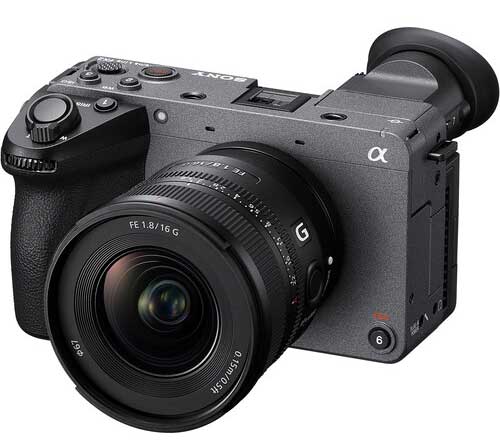
Sony announced the Sony FX2 camera. The camera is a mixture of the Sony A7 IV 33MP sensor and FX3 body. Now we have an AI chip inside the camera. The autofocus speed has been increased by up to 30%, and the tracking has been improved dramatically compared to the Sony Camera AIV. We have lots of new modes that include auto framing, framing stabilizer, and AI tracker that make the entire camera a kind of powerhouse Swiss Army knife.
Video capabilities also extend its boundaries to the maximum extent. Now we have certain angle DCI 4K and true 24fps recording. For professionals and videographers, we have an anamorphic recording mode in-camera, discreetly, as well as 24-bit audio recording capability with the help of XLR input.
Sony FX2 Specification
- Sensor: 33MP full-frame BSI CMOS (from a7 IV)
- Video:
- 4K up to 30p (7K full-width oversampled)
- 4K up to 60p (1.5x APS-C crop)
- DCI 4K with true 24p
- Autofocus: AI-based, 30% better recognition, auto-framing, AI tracker
- Shutter: Mechanical, movie/stills switch
- Viewfinder: 3.68M-dot tilting EVF, 0.7x magnification
- Storage: 1x CFexpress Type A/SD, 1x SD (redundant recording)
- ISO: Dual native (800, 4000), clean up to 25,600, usable at 51,200
- Extended Features:
- Shutter angle
- 4K30 UVC streaming (USB-C)
- Focus breathing compensation
- Dynamic active stabilization
- S-Log Photo mode
- 4K JPEG shot mark grabs
- Active cooling (unlimited recording)
- HDMI Type A, headphone/mic jacks
- Dual 1/4-20 tripod holes
- FX3/FX30 XLR handle compatible
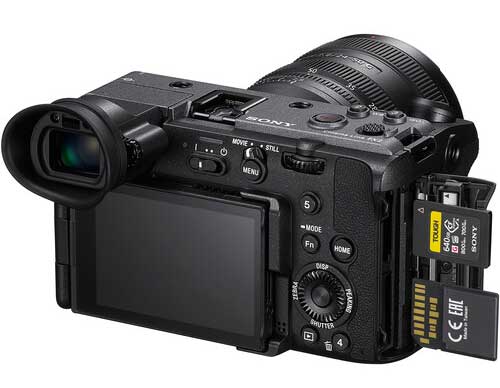
Focus breathing compensation as well as dynamic active image stabilization also help this camera to explore a new dimension of usability and portability. However, the FX2 retains the Sony A7 IV 4K 60fps crop limitation. That’s really disappointing. Sony can add a line-skipping 4K 60 APS-C mode in their camera so users can have the uncropped version of 4K 60p recording by having a bit of loss in quality.
The price of the camera is expected to be somewhere around $2698. B&H Store
Sony Electronics Introduces the FX2 Compact Camera, Expanding Cinema Line’s Versatility for Creatives
The new FX2 has the look and operability of Cinema Line cameras with the ability to shoot high-resolution photos and comes equipped with an articulating eyepiece
Sony Electronics Inc. is proud to announce today the latest addition to its established Cinema Line family, the FX2. The FX2 will offer a seamless entry point into the broader Cinema Line range, giving greater cinematic expression to independent creators or small crews needing a versatile camera.
“The hybrid cinema camera was created based on user feedback and is engineered with unique features to support filmmaking, a new eyepiece, and enhancements for versatile production needs. The FX2 is intended to continue the Cinema Line’s goal of preserving authentic emotion in every shot and empower creators across all areas of content production,” says Theresa Alesso, President, Imaging Products and Solutions Americas, Sony Electronics Inc.
FX2 Features: Full-frame Photo and Video Capabilities
The FX2 comes with a full-frame sensor that delivers stunning imagery and beautiful bokeh effects. Equipped with a 33.0 effective megapixel1 back-illuminated Exmor R™ sensor with up to 15+ stops of wide latitude using S-Log3, it captures impressive detail in both highlights and shadows.
Designed for versatile shooting environments, the FX2 offers Dual Base ISO at 800 and 4000, ensuring optimal performance in both bright and low-light conditions. Its ISO sensitivity for video can be extended up to 102400, making it ideal for challenging lighting scenarios. The camera supports a wide range of recording formats—including 4:2:2 10-bit All-Intra—and records in high-quality options, such as XAVC S-I DCI 4K at 24.00p, providing professionals with the tools needed for flexible, high-end production workflows.
The FX2 can also continuously record for up to 13 hours in 4K 60p2 thanks to its internal cooling fan and effective heat dissipation structure. The FX2 offers variable frame rate settings, allowing up to 60 fps in 4K (for a maximum 2.5x slow-motion effect) and up to 120 fps in Full HD (for up to 5x slow motion). It supports Log shooting in Cine EI, Cine EI Quick, and Flexible ISO modes, offering versatile workflows for different production needs. To further the cinematic expression of the camera, creators can import up to 16 user LUTs for on-camera preview, enabling precise color monitoring on set.
Filmmakers can also easily and quickly create in-camera cinematic looks, with S-Cinetone™ set as the default, along with a range of Picture Profile and Creative Look presets. A de-squeeze display function is available, supporting both 1.3x and 2.0x anamorphic lenses for accurate framing.
Improved Usability for Comfortable Solo Operation
The FX2 features the same compact, flat-top design as Sony’s Cinema Line FX3 and FX30 cameras, ensuring familiarity and compatibility across setups. Built-in mounting points (UNC 1/4-20 x3) support a cageless configuration, offering greater flexibility for rigging. An optional top handle (ILME-FX2) enhances mobility and control, especially during handheld or dynamic shooting. Its lightweight, portable build—measuring approximately 5 1/8 x 3 1/8 x 4 1/8 in and weighing approximately 1 lb 8.0 oz—makes it ideal for solo operators or small crew productions.
The camera offers advanced focus features designed for precision and creativity. Its new Real-time Recognition AF (auto focus) delivers fast and reliable performance with improved accuracy for human subjects, although its intelligent subject recognition extends to animals, birds, vehicles, and insects, with an Auto mode available for effortless detection. For even more control, tools like focus breathing compensation, AF Assist, and customizable autofocus transition speed and sensitivity give creators the flexibility to fine-tune focus for expressive, cinematic imagery. The FX2 comes with Active Mode and Dynamic active Mode, which is new to the Cinema Line, and are both designed to ensure smooth and steady handheld shooting.
The Auto Framing feature automatically crops and tracks a subject to keep them in a prominent position when the camera is mounted on a tripod, producing footage that looks like it was shot by an experienced operator. The Framing Stabilizer function automatically keeps the subject in the same position within the frame, which can be useful, for example, when the camera operator is moving alongside the subject.
From a still image perspective, the camera features an additional log shooting option with a newly added ‘Log shooting’ menu. This feature allows creators to shoot high-resolution 33MP stills, optimized for color grading in post-production. The FX2 also offers smooth operation with a MOVIE/STILL mode lever, allowing for a quick switchover between still and movie shooting. Depending on the selected mode, the displayed menu items will automatically adjust. Additionally, mode selection is made easy with a long press of the Fn button, which recalls and changes the shooting mode.
FX2 Features: Improved but Familiar Hardware Inherited From Sony’s Cinema Cameras
The FX2 is equipped with a new high-resolution 3.68-million-dot tiltable EVF3 (electronic view finder) designed specifically for video production, offering a wide viewing angle and enhanced immersion thanks to its included deep eyepiece. Complementing the EVF is a 3.0-type vari-angle touchscreen LCD, making it easy to frame shots from virtually any angle. Intuitively arranged controls on the top panel and grip, along with tally lamps for clear recording status, support efficient on-set operation. The camera also introduces a customizable “BIG6” home screen that provides quick access to essential shooting parameters, such as FPS, ISO, shutter speed (angle or speed), Look presets, white balance, iris, and neutral-density (ND) filter settings. Addressing the growing demand for vertical content creation, the FX2 supports vertical menu display during shooting—ideal for social media formats. The handle-equipped model further enhances professional usability with two XLR/TRS terminals and a 3.5mm stereo mic jack, enabling 4-channel, 24-bit digital audio capture.
The camera offers extensive expandability and connectivity options, including an HDMI Type-A terminal capable of outputting up to 4K 60p 4:2:2 10-bit video and 16-bit RAW4 for high-end recording and monitoring. For seamless data transfer and remote control, it supports dual-band Wi-Fi (2.4 GHz and 5 GHz5) as well as wired LAN via a compatible adapter6. Additionally, the USB Type-C port enables SuperSpeed USB up to 10Gbps data transfers and supports USB Power Delivery (PD)7, while built-in USB and network streaming support enables live broadcasting and remote production workflows.
Social Responsibility
Aligned with Sony’s global environment plan, ‘Road to Zero’, this product supports the company’s vision for achieving a zero environmental footprint by 2050. The manufacturing process reflects this commitment through facilities powered entirely by renewable energy sources8.
The camera system incorporates comprehensive accessibility options, including a Screen Reader function9 and Display Magnification, to support visually impaired users across an expanded range of menu items. Additional intuitive controls enhance usability for all shooters, featuring:
- Real-time recognition autofocus that reduces manual adjustments
- Streamlined touch interface operations for direct menu navigation
- Tactile button design with clear differentiation
These inclusive design elements ensure professional imaging tools remain accessible to creators of all abilities while maintaining full operational capability
The FX2 will be available early August for a suggested retail price of $2,699.99 USD and $3,499.99 CAD body only or $3,099.99 USD and $3,999.99 CAD with XLR handle. It will be sold directly through Sony and at a variety of Sony’s authorized dealers throughout North America.
By admin, on May 28th, 2025
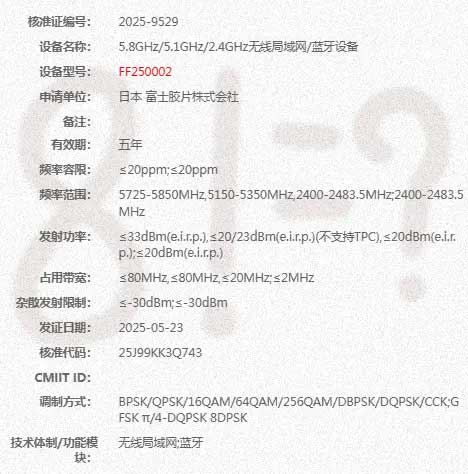
Fuji Registers New Cameras for 2025 Launch – Fuji registers a new camera in the wireless certification agency, so it has become a total of 3 cameras which are in the announcement pipeline. One of them is almost confirmed, which is coming on June 11 — the Fuji XE5 camera. The rest of the two cameras are still unknown, can be a GFX camera or maybe an X-Pro 5.
Fuji Unreleased and Registered Camera Models May 2025
The following table summarizes Fujifilm’s unreleased camera models and their known registered models, providing context for the new registrations:
| Model Code |
Camera Model |
Registration Date |
Wireless Type |
Status |
| FF250001 |
Likely X-E5 |
Not specified (spotted early 2025) |
Multi-band wireless |
Unreleased |
| FF250003 |
Unknown (possibly X-M5 Range Camera) |
Not specified (spotted May 2025) |
Single-band wireless |
Unreleased |
| FF250002 |
Unknown (possibly GFX Eterna) |
Not specified (spotted May 2025) |
Not specified |
Unreleased |
| FF210002 |
X-H2S |
2021-11-09 |
Not specified |
Released |
| FF210003 |
X-H2 |
2022-06-20 |
Not specified |
Released |
| FF220001 |
X-T5 |
2022-08-24 |
Not specified |
Released |
| FF230001 |
GFX100 II |
2023-01-13 |
Not specified |
Released |
| FF220002 |
X-S20 |
2023-02-03 |
Not specified |
Released |
| FF230002 |
GFX100S II |
2023-06-19 |
Not specified |
Released |
| FF230003 |
X100 VI |
2023-11-24 |
Not specified |
Released |
| FF240001 |
X-T50 |
2023-12-08 |
Not specified |
Released |
| FF240002 |
X-M5 |
2023-06-28 |
Single-band wireless |
Released |
| FF240004 |
GFX100RF |
2024-12-04 |
Not specified |
Released |
| FF240003 |
X-Half |
Not registered with CMIIT |
Not specified |
Released |
Notes:
Although three models are mentioned, FF250001 and FF250003 have already been registered. The model registered this time is “FF250002”.
While the FF250003 only supports 2.4GHz, the FF250003 and FF250002 also support 5.1GHz. Most recent models, except for small and lightweight models, support 5.1GHz Wi-Fi, so it is not possible to predict the price range of the camera based on this information alone. It is interesting to see whether it will be an X series model or a new model in the GFX series.
It is rumored that the “X-E5” will on June 11, 2025. More details here
Follow us for more updates and Get LIVE RUMORS –> FACEBOOK | TWITTER | INSTAGRAM to get live news — > get live news + –> See More Fuji Rumors
source E88_8888
By admin, on May 28th, 2025
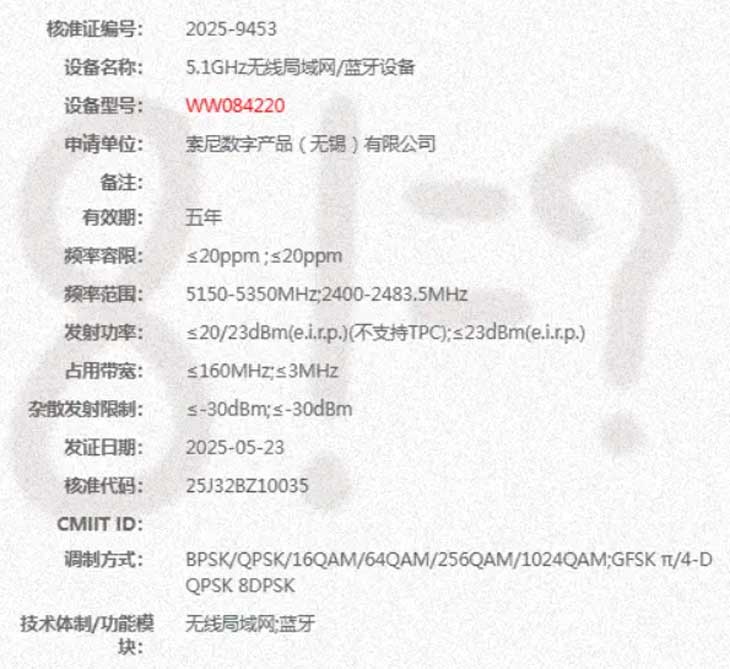
Sony registered a new mirrorless camera on May 23, 2025, and the most important factor is that the manufacturing division of this mirrorless camera is at Wuxi city, where most of the VLOGCAM and semi-professional cameras of Sony are manufactured.
Where is the breakdown of Sony’s manufacturing factories? You can have a good idea where they manufacture the high-end Alpha cameras or the intelligent compacts.
Sony Alpha Cameras Manufacturing Unit Worldwide
- Sony Japan: High-end products such as the α1, α9 III, and FX3
- Sony Shanghai: Cinema line and video products such as FX9 and FX6
- Sony Wuxi: Low to mid-range products such as ZV-1F, ZV-E10M2, α7 IV, and α7C
Sony Upcoming Camera Models Codes Updated List
| Model number |
Model |
correspondence |
Registration date |
manufacturing |
| WW084220 |
|
5.1/2.4
Bluetooth |
2025.05.23 |
Wuxi |
| WW697160 |
|
5.1/2.4
Bluetooth |
2025.05.09 |
Japan |
| WW934774 |
FX2? |
5.1/2.4
Bluetooth |
2025.04.21 |
Shanghai |
WW045578
WW912257 |
α1 II |
5.1/2.4
Bluetooth |
|
Japan |
| WW279317 |
Cinealta B MPC-2610 |
5.1/2.4 |
2023.09.20 |
Shanghai |
| WW293541 |
ZV-E10 II |
5.1/2.4
Bluetooth |
2024.03.25 |
Wuxi |
| WW030588 |
microphone? |
2.4GHz |
2025..1.10 |
|
WW773396
WW277226 |
ILME-FX3A |
5.1/2.4
Bluetooth |
2024.12.04 |
Japa |
So there is a very high probability that this camera is a VLOGCAM or maybe an update to the existing A7 IV / Sony A7 V, coming next from Sony. Based on past trends, we expect the registered camera to be announced on or before September 2025, so we may see some additional information by the summer.
follow us on our social pages FACEBOOK | TWITTER | INSTAGRAM, –>If you have time –>see more Sony Alpha Rumor Latest Camera News
source E88_8888
|
KEEP THIS BLOG ALIVE - Support New Camera Buy Canon Lenses, Buy Music CD or Digital Camera at amazon it helps this site, and you do not pay anything extra, it is just a way to help support this site.

|
















